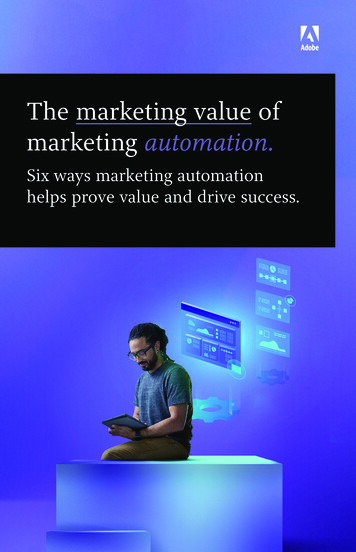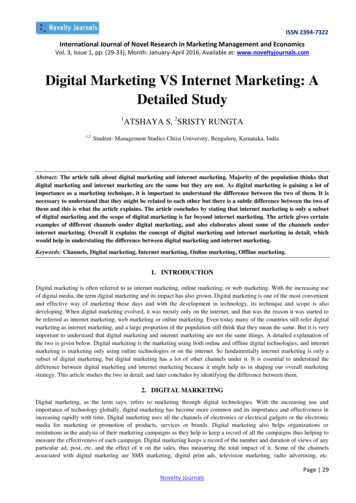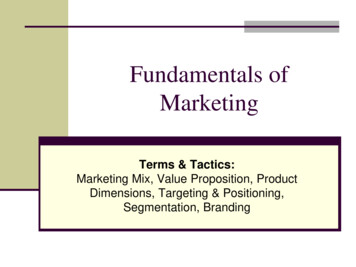
Transcription
The marketing value ofmarketing automation.Six ways marketing automationhelps prove value and drive success.
As a marketer, digital transformation has changed how you do yourjob. And what customers expect from your efforts. You’replanning, building, and delivering increasingly complex customerexperiences. And in an age where everything can be precisely trackedand measured, you probably feel increasing pressure to prove theimpact of your contributions. The right solutions and processes can dojust that by helping you hit ambitious goals and demonstrate yourresults to diverse stakeholders.Turn your challengesinto opportunities.In the digital age, marketers face key challenges, including these: Managing multiple programs across many channels Sustaining content through long sales cycles Acquiring qualified leads to share with the sales team Aligning sales and marketing teams to focus on customer experience Demonstrating ROI to prove organizational value2
Marketing automation can help you address each of these challenges bygiving you the power to scale programs, deliver personalized and targetedcontent to customers, align your internal teams with integrated technology,and measure the impact of your efforts across channels. With it, you cangather all the data you need, carefully consider all your options for using iteffectively, assemble targeted content, anticipate customer trends, anddeliver customer experiences that resonate.In short, the right marketing automation solution helps you take yourbusiness to the next level. Organizations that focus on customer experienceusing marketing automation connect powerfully with their customers—andrealize significant business value. They enjoy lower acquisition costs,increased conversion rates and prospects, higher average order value, higherretention, and increased loyalty.3
Define marketingautomation to redefinehow you connect withcustomers.Making customer experience the heart of your business requiresin-depth digital transformation—old marketing tools, data-gatheringsystems, and outdated technology simply won’t cut it. That’s wheremarketing automation comes in.Marketing automation is designed to help you streamline, automate, andmeasure marketing tasks and workflows. By taking on some of the morerepetitive and time-consuming aspects of your marketing strategy,automation increases operational efficiency—and helps your teams growrevenue faster.Your marketing automation solution should do the following: Centralize data. Orchestrate cohesive customer experiences. Run robust analytics.4
Right now, you may be completing each of these tasks manually, whichputs your organization at a disadvantage. Because it’s now necessary toscale all experiences to meet individual customer preferences acrosschannels, consider how marketing automation can scale content effectively,while leaving more time for your marketing team to innovate.“While marketing automation has always beenabout amplifying messages through speed andscale, the next wave is about being predictive,personal, and more selective about tools.”Nick EdwardsCEO and Co-Founder, BoomtrainThe right time to investis right now.Each day, we’re inundated with messages. According to CampaignMonitor, the average office worker receives between 120 and 150 emailsper day, including content, deals, event invitations, and more. Each one ofthose emails competes for a small but highly prized outcome. Attention.5
That’s why a one-size-fits-all approach doesn’t work anymore. In fact, emailswith personalized subject lines are 26 percent more likely to be opened,and marketers using segmented campaigns enjoy a 760 percent increase inrevenue, as Campaign Monitor has shown.To stand out, you need more than a solid email strategy. You need a strongbrand presence across channels to help you stand out from the crowd—and resonate with consumers. Buyers form opinions and draw conclusionslong before they ever interact with your brand. Make sure yourcommunications strategy spans the entire sales funnel.Marketing automation helps you curate experiences to engage customers inevery touchpoint across the entire sales cycle. Overall, marketingautomation helps your entire organization adopt a mindset of digitalmaturity and customer experience excellence.75% of marketers say they currently use at leastone type of marketing automation tool.Source: Social Media Today6
Six reasons to adopt themarketing automationmindset.Marketing automation helps you deepen and expand customerexperiences—and drive your ongoing digital transformation. Byengaging buyers in every stage of their evolving buying journey throughlead and account-based strategies, marketing automation helps you targetand connect with consumers through meaningful, relevant experiences.The right marketing automation solution is comprehensive, designed tohelp you accomplish your goals toward digital maturity. Here are six topcapabilities that marketing automation can provide, which double as sixpowerful reasons to invest.1.Manage prospects from inquiry to close with lead nurturingand management.2.Close your most strategic opportunities with account-based marketing.3.Make the most of every interaction using machine learning andpredictive analytics to personalize content and experiences at scale.4.Connect with leads and accounts on every channel withcross-channel engagement.7
5.Align marketing and sales teams throughout your organization withintegrated sales applications.6.Understand, prove, and optimize your marketing efforts withmarketing measurement and attribution tools.“Customer experience is perhaps as much amindset and business philosophy as a discipline.”Ashley FriedleinFounder, Econsultancy1. Manage prospectswith lead nurturing.Lead nurturing can help you capture—and maintain—buyer attention.It helps you shift your focus from individual touchpoints to a holistic,well-rounded view of the entire buyer experience. In fact, lead nurturing isall about building and maintaining relationships across complex buyingjourneys filled with many touchpoints. Using the right lead-nurturingsolutions, you can personalize experiences and drive deeper levels ofconnection with each and every buyer.8
Marketing automation provides the polling and referral capabilities youneed to collect lead information, which you can then use to personalizeexperiences and cultivate long-term engagements. In all these ways, leadnurturing helps you create customer-centric experiences and relationshipsby focusing on each touchpoint in the sales cycle and across any channel.What’s more, marketing automation also helps you find and attract morequalified leads.Done effectively, lead nurturing results in shorter sales cycles, increasedaverage selling price, and overall increases in sales productivity. Marketingautomation can help you manage prospects from inquiry to close bycapturing, scoring, nurturing, routing, and tracking leads with sophisticatedjourney flows and robust CRM integrations.“Marketo research shows that nurtured leadsmake 47% larger purchases than non-nurturedleads. Targeting specific actions and audiencescan help you track warm leads all the wayto purchase.”Lizzy RagnoEnterprise Campaigns, Adobe9
2. Close strategicopportunities withaccount-based marketing.While account-based marketing (ABM) isn’t a new concept, it’s newlyinvigorated by innovative technologies that make it easier to focusyour efforts on a defined set of target accounts. No longer a tool best suitedfor enterprise brands alone, ABM now makes sense as a strategic approachfor companies of all sizes. Improved data capabilities, including artificialintelligence, have made ABM more personal and more effective thanever before.For an example of how ABM works today, consider the speed it brings tocampaigns. A typical direct mail campaign could require over 20 steps tocreate and hours of copying and editing each workflow individually, as wellas creating new, additional steps. But marketing automation solutions thatinclude ABM powered by AI give you the power to automate campaigncreation. And account-level segmentation lets you drive automated ABMcampaigns across channels—including email, web, ads, mobile, events,webinars, and more. All from the same solution.10
“Over 70% of B2B companies have adopted orare planning to adopt ABM practices in the nextyear, according to eMarketer. As well theyshould: ITSMA reports that of the companiesthat adopted ABM in the past two years, 55%are seeing significantly higher ROI than withtraditional marketing.”Source: CMO.comRecent research from Adobe Digital Insights reveals that mobile sitetraffic and engagement has grown over the past three years on B2Bsoftware company websites, as engagement has decreased on desktopdevices. These days, account-based marketing can help you close your moststrategic opportunities by identifying and engaging accounts with thehighest potential. As a bonus, marketing automation solutions can also helpyou easily measure the efficacy of these targeted efforts.11
3. Personalize everycustomer’s experience.There’s a pervasive belief that the human attention span has reduced tothat of a goldfish in the last few decades, suggesting that the manydigital distractions demanding our attention have stolen our ability to focus.While it may be true that we decide what content to engage with in mereseconds, we’re still capable of making deep connections, and it’s undeniablethat consumers care about how they spend their time online. After all, wewouldn’t bounce around so quickly if we weren’t looking for quality reasonsto slow down and get engaged.This is why personalizing experiences at scale has become so critical tomarketing. When content feels customized to unique buyer needs andinterests, it’s that much easier to capture lasting attention and investment.Authentic communication goes a long way these days.“By combining the data collection, automation,and predictive capabilities of machine learningwith your creativity as a marketer, your companycan optimize and scale its campaigns to createmore personalized and engaging content.”Santiago PomboSenior Product Manager, Adobe12
Website personalization tools show you demographic and behavioral dataabout individual customers, which you can use to share content that will bemore relevant to them. This tool also helps with retargeting efforts—helping you match advertisements with the demographics, purchase history,buying intent, lead score, and other details of individual site visitors.Website personalization and predictive content help you deliver the mostrelevant content to everyone who interacts with your brand—whetherthey’re on your site or opening up your latest email. Through websitepersonalization, you can begin to make deep connections with all prospects,even anonymous visitors. And predictive content helps you match yourexisting content with the right customers, at the right time.“By tapping into artificial intelligence and machinelearning to create spot-on relevant experiencesand automation to scale, brands can curateunparalleled customer journeys that far exceedwhat human marketers can deliver.”Kevin LindsayDirector of Product Marketing, Adobe Experience Manager Assets, Adobe13
4. Deliver engagingcontent on every channel.One of the key challenges in creating customer experiences is shiftingfrom a focus on individual channels to the bigger picture of howindividual customers move through diverse touchpoints. Marketingautomation can help with that, in more ways than one.By driving cross-channel engagement, marketing automation helps youengage leads and accounts with targeted experiences on every channel,including email, mobile, social, display, search, website, events, and sales.Such a perspective shifts channel-specific goals toward the bigger picture—understanding each individual customer so well that you can delivertargeted, meaningful content to them no matter what channel they’re on.“An omnichannel strategy is about creating amutually rewarding, connected experience acrossonline and offline channels, rather than focusingon audiences, content, and messaging for eachindividual channel.”Source: Adobe14
Marketing automation can also help you understand how each channelworks together and drives your larger goals. As Kristin Naragon hasexplored, the way we measure a channel’s value shifts under this model. Forexample, instead of seeing the value of an email in terms of its opens, clicks,and conversions, marketing automation allows us to explore how emailassists with conversions in other channels and, as she puts it, “how it boostslifetime value, customer satisfaction, and brand engagement.”“The biggest challenge for marketers often isn’tthe technology; rather, it’s how to knit thosetechnologies together to create fluid experiencesthroughout customer lifecycles.”Danny DaltonIndustry Strategy Group, Adobe15
5. Align your sales andmarketing teams.As you work toward gaining a holistic perspective on your customers,your organization should also take a more holistic approach acrossteams. By aligning your sales and marketing teams, you can enjoy increasedrevenue, a shortened and more productive sales cycle, improvedconversion rates, and improved forecast accuracy.One simple result of aligning teams is that the customer experience getsbetter. When your marketing team works with your sales team to planexperiences, you’re more likely to create content that keeps customersengaged. This is coordinated aircover, where both teams have visibility intothe other’s process—creating a bank of shared insights that allow for amore coordinated, cohesive buyer journey.When everyone focuses on the importance of the holistic customerexperience, it becomes easier to work together and align goals. By usingintegrated sales applications, you can align your teams as you tap into newlevels of visibility between stakeholders. Within those applications, you canshare insights, templates, and sales playbooks that help sales teams engagetop opportunities identified and nurtured by the marketing team.16
“Businesses with highly aligned sales andmarketing teams earned an average of 32% yearover-year growth, while those who reported lessalignment saw a 7% decrease in revenue.”Ray MeiringCEO and Co-Founder, Qorus Software6. Measure everymarketing effort.Marketing analytics, a key feature of marketing automation, gives youmore sophisticated ways to measure ROI for your campaigns. Thedata and insights collected can reveal which of your efforts are mosteffective, so you can improve your efforts in real time and connectpowerfully with buyers at all stages in the sales cycle.Marketing analytics illustrates the full scope of the buyer’s experience,including showing you where a customer got involved with your brand—what content or touchpoint caught their attention—and then detailingevery successive move they made along the way to purchase. In otherwords, marketing analytics allows you to learn more about your individualcustomers as you gain a holistic perspective on the experiences you provideas customers navigate them. This gives you an in-depth look at where youcan improve said experiences.17
With attribution that measures every touchpoint in the buyer journey, youcan also use marketing analytics to accurately identify which channels andcampaigns deliver the most revenue and highest ROI. And that makes iteasier for your teams to confidently plan and place resources where theywill reach customers best.Robust analytics solutions include comprehensive attribution capabilitiesthat streamline the way marketers illustrate their impact and empoweroverall business growth. Pre-built dashboards and flexible ad hoc reportingprovide actionable insights that help you focus your efforts. You’ll get areturn on your investment—and save time, too.Overall, marketing analytics help you understand, prove, and optimizemarketing impact with comprehensive campaign performance andattributed revenue analytics.“It starts with data, and then building upon that—getting an understanding of who customers andprospects are and what data sources you have.”Bruce SwannGroup Product Manager, Adobe18
A holistic customerexperience requires aholistic sales funnel.As your organization embraces the importance of the customer journey,you should also refresh your perspective on the sales funnel. Thinkabout marketing efforts throughout the entire process—from inboundleads to closed deals. With a full-funnel perspective on marketing, you canalso streamline how your internal marketing and sales teams work together.Marketing automation helps marketers throughout the sales cycle—and ithelps everyone find common ground in the quality of the customerexperience. The six capabilities we’ve explored here also align to the salesfunnel, showing the stages in which marketers and sales teams can worktogether. They are as follows:Attract. Drive more inbound web traffic and convert web visitors to leads.Engage. Deliver the right message to the right person at the right time—and accelerate their journey.Close. Increase lead quality for sales to help them win more deals.Using this framework, you can understand how the six capabilities ofmarketing automation align to the sales funnel — creating cohesion acrossthe customer journey for marketing and sales teams alike.19
Six capabilities that marketing automationbrings to the sales funnel.AT TRAC TMarketing automation helps everyone drive top-of-funnel engagements,and it allows you to complete the following tasks:1. Pursue high-value prospects with lead nurturing and lead management.2. Connect across every channel with personalized engagement.ENG AGEMarketing automation solutions give you the power to communicate with potentialbuyers over time, at scale, and in personalized ways. With it, you can build moreeffective experiences for customers and employees alike:3. Scale experiences and content with machine learning and predictive analytics.4. Further align your marketing and sales teams with integrated sales applications.CLO SEMarketing automation isn’t just for marketers—it can also help your sales teamclose deals faster. Use it to help everyone drive results that make a difference:5. Trust account-based marketing to help close deals.6. Implement marketing measurement and attribution tools to track success.20
Marketing automation isyour key to the future.Marketing automation helps you accomplish your biggest goal in thedigital age: to connect with customers across an array of channels,and to guide them from first interaction to final sale. It helps you attract,engage, and close sales. And it helps your marketing and sales teams worktogether to accomplish their tasks—from increasing lead generation andnurturing customers with personalized content to driving high-quality leadsall the way to conversion.What’s more, marketing automation also provides key measurement toolsthat help everyone track effectiveness, make changes as they go, andimprove the probability of success in the future. All in all, marketingautomation expands the potential of your teams, allowing everyone toexplore and implement diverse strategies and take action.In years past, marketing automation has been treated as a perk—a “nice-tohave” for large, sophisticated marketing teams. But these days, it’s amust-have for teams large, small, and everywhere in-between. Because asbusinesses pursue digital transformation and seek to become the digitallymature leaders of tomorrow, marketing automation solutions will be theway they get there.21
SourcesBrad Rencher, “Make Experience YourBusiness,” Adobe Summit, 2017.Brittany Chandler and Reid Schoffelen,“Why An Account-Based ExperienceStrategy Is Now a B2B Must,” CMO.com,2019.“Create Seamless Customer Experienceswith Omnichannel Marketing,” Adobe.Bruce Swann, “What Is MarketingAutomation Anyway, and What Can It Dofor You?” Adobe Blog, April 6, 2018.Danny Dalton, “Omnichannel TechnologyStrategies Deepen and Lengthen theCustomer Lifecycle,” Adobe Blog, February22, 2018.“Experience Index: 2019 Digital Trends,”Econsultancy and Adobe, 2018.“How Adobe Used Its Experience Platformto Create Behavioral Signals,” Adobe DigitalInsights, November 13, 2018.Kevin Lindsay, “Why Automation is YourStrategic Advantage in the PersonalizationWars,” Adobe Blog, February 22, 2017.Krisin Naragon, “Email Marketing Holds theKey to Igniting Customer Obsession,”Adobe Blog, June 15, 2018.Lizzy Funk (Ragno), “MarketingAutomation Workflows Every MarketerShould Know,” Adobe Blog, February 8,2019.Nick Edwards, “Three Predictions Aboutthe Future of Marketing Automation,”CMO.com, March 15, 2016.“The Shocking Truth about How ManyEmails Are Sent,” Campaign Monitor Blog,May 21, 2019.Ray Meiring, “Content Can Fix theDisconnect Between Sales and Marketing,”CMO.com, January 26, 2017.Santiago Pombo, “The Future of ContentMarketing: How Machine Learning andUGC Drive Scale,” Adobe Blog, June 7, 2018.Sathvik Tantry, “Making PersonalizedMarketing Work,” Harvard BusinessReview, February 29, 2016.“State of Marketing Automation SurveyReport,” Social Media Today, 2019.“Wow Your Customers with anOmnichannel Digital Experience,” AdobeBlog, August 31, 2017.“You Have 2.7 Seconds to Grab Someone’sAttention, No Pressure,” Create & Cultivate,April 26, 2019.Copyright 2020 Adobe Inc. All rights reserved. Adobe andthe Adobe logo are either registered trademarksor trademarks of Adobe Inc. in the United States and/orother countries.
capturing, scoring, nurturing, routing, and tracking leads with sophisticated journey flows and robust CRM integrations. "Marketo research shows that nurtured leads make 47% larger purchases than non-nurtured leads. Targeting specific actions and audiences can help you track warm leads all the way to purchase." Lizzy Ragno











